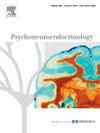Lifetime heterosexist victimization and diurnal cortisol predict depression trajectories among sexual and gender minority emerging adults
IF 3.6
2区 医学
Q2 ENDOCRINOLOGY & METABOLISM
引用次数: 0
Abstract
Heterosexist victimization constitutes a severe source of social stress with enduring effects on mental health and the adrenocortical functioning of lesbian, gay, bisexual, transgender, and queer (LGTBQ) emerging adults. However, it is unknown what roles lower or higher diurnal cortisol at waking (cortisol intercepts) and less variable fluctuations (“flatter” slopes) play in the links between heterosexist victimization and depressive symptoms. In accordance with diathesis-stress, allostatic load, and biological embedding perspectives, we examined whether cortisol intercepts and slopes moderated or mediated the predictive associations of heterosexist victimization with depressive symptoms over 24-months. Heterosexist victimization was expected to predict depressive symptoms most strongly for LGBTQ emerging adults with flatter cortisol slopes (i.e., moderation), and cortisol intercepts and slopes were expected to indirectly link heterosexist victimization with depressive symptoms (i.e., mediation). Latinx and White LGBTQ emerging adults (N = 97; ages 18–29, M = 23.91 years, SD = 2.63) provided saliva samples and questionnaire responses during a four-day testing protocol at baseline; two additional assessments of depressive symptoms were completed 9- and 24-months later. Cortisol intercepts and slopes moderated associations of heterosexist victimization with both contemporaneous and prospective depressive symptoms. Heterosexist victimization was positively associated with contemporaneous depressive symptoms and decreases in depressive symptoms over two years when LGBTQ emerging adults also had steeper cortisol slopes. Heterosexist discrimination was associated with increases in depressive symptoms prospectively among participants with lower cortisol intercepts. There was no evidence for mediation. Thus, patterns of diurnal adrenocortical functioning may distinguish between LGBTQ emerging adults who are more prone to acute versus prolonged depressive symptoms when they experience heterosexist victimization.
终生异性恋受害者和每日皮质醇预测性少数和性别少数新兴成年人的抑郁轨迹
异性恋受害者构成了社会压力的一个严重来源,对女同性恋、男同性恋、双性恋、变性人和酷儿(LGTBQ)新兴成年人的心理健康和肾上腺皮质功能有着持久的影响。然而,尚不清楚清醒时较低或较高的皮质醇(皮质醇拦截)和较少的可变波动(“平坦”斜率)在异性恋者受害和抑郁症状之间的联系中起什么作用。根据素质应激、适应负荷和生物嵌入的观点,我们在24个月内研究了皮质醇拦截和倾斜是否调节或介导异性恋受害与抑郁症状的预测关联。异性恋者受害被认为最能预测皮质醇斜率较平(即,适度)的LGBTQ新兴成人的抑郁症状,皮质醇拦截和斜率被认为间接地将异性恋者受害与抑郁症状联系起来(即,调解)。拉丁裔和白人LGBTQ新兴成人(N = 97;年龄18-29岁,M = 23.91岁,SD = 2.63),在为期四天的基线测试方案中提供唾液样本和问卷回答;9个月和24个月后完成了对抑郁症状的两次额外评估。皮质醇阻断和斜率调节异性恋受害与同期和预期抑郁症状的关联。异性恋受害者与同期抑郁症状呈正相关,并且在两年内LGBTQ新兴成人的皮质醇斜率也更陡时,抑郁症状有所减少。在皮质醇截距较低的参与者中,异性恋歧视与抑郁症状的增加有关。没有调解的证据。因此,日常肾上腺皮质功能的模式可以区分LGBTQ新兴成人,当他们经历异性恋受害者时,他们更容易出现急性抑郁症状和长期抑郁症状。
本文章由计算机程序翻译,如有差异,请以英文原文为准。
求助全文
约1分钟内获得全文
求助全文
来源期刊

Psychoneuroendocrinology
医学-精神病学
CiteScore
7.40
自引率
8.10%
发文量
268
审稿时长
66 days
期刊介绍:
Psychoneuroendocrinology publishes papers dealing with the interrelated disciplines of psychology, neurobiology, endocrinology, immunology, neurology, and psychiatry, with an emphasis on multidisciplinary studies aiming at integrating these disciplines in terms of either basic research or clinical implications. One of the main goals is to understand how a variety of psychobiological factors interact in the expression of the stress response as it relates to the development and/or maintenance of neuropsychiatric illnesses.
 求助内容:
求助内容: 应助结果提醒方式:
应助结果提醒方式:


